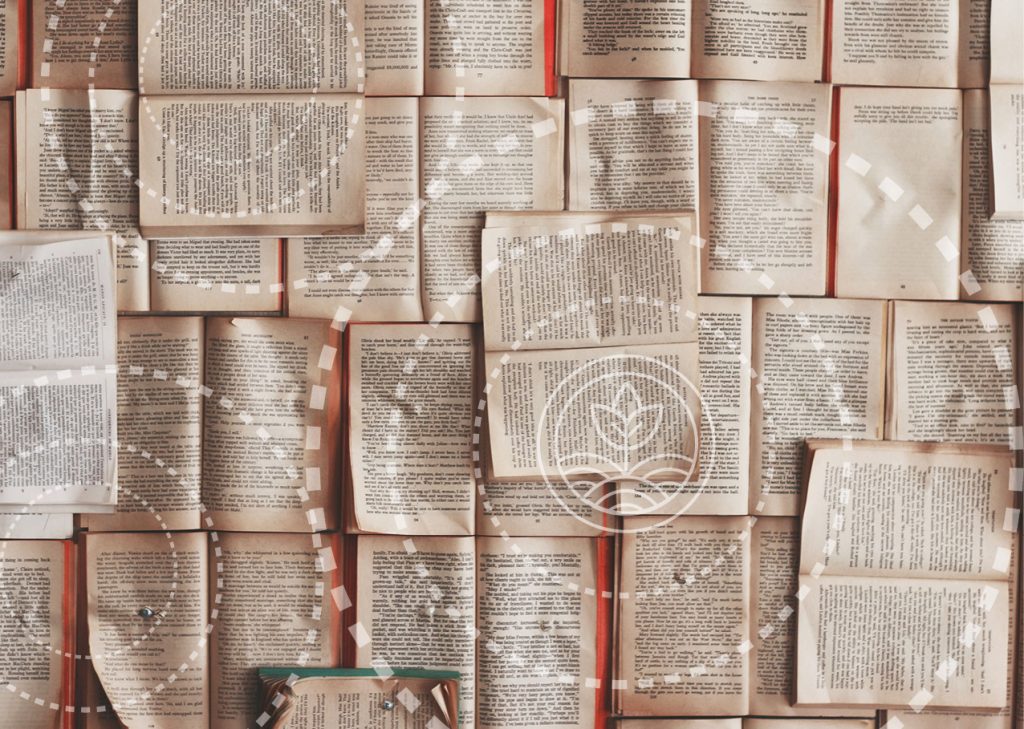Diary of a Teenage Girl An Account in Words and Pictures – Phoebe Gloeckner
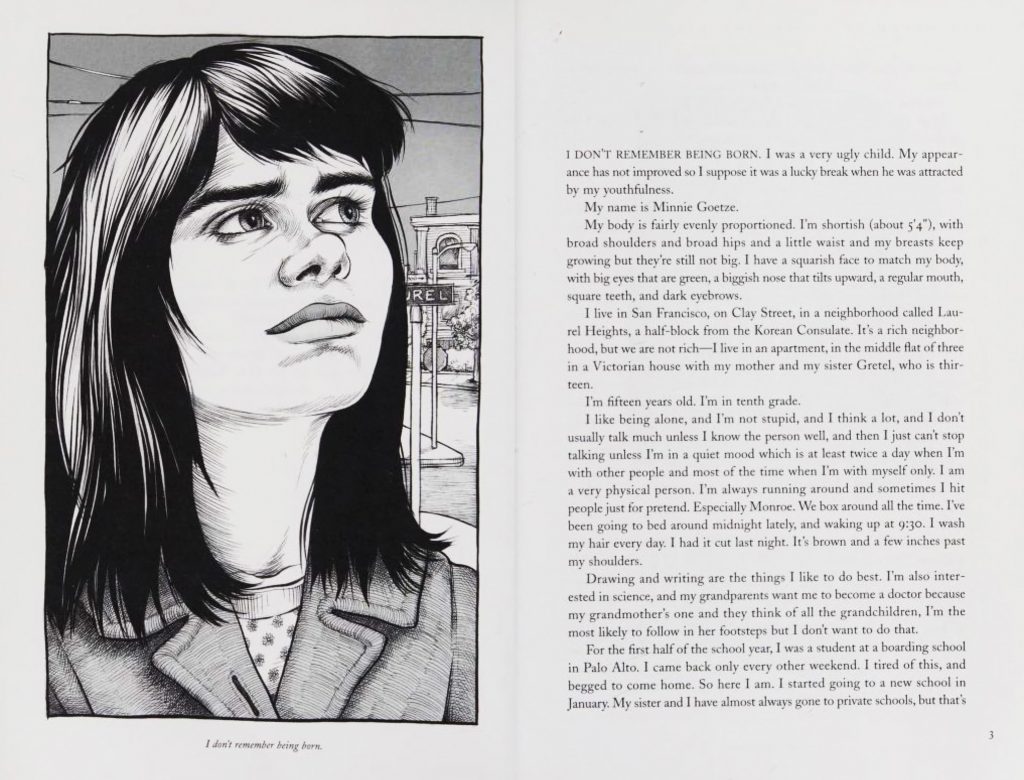
Phoebe Goeckner is a comic artist and medical illustrator with links to the underground comix scene in San Fransciso in the 1970’s. This particular work is semi-autobiographical, with a main character who looks, acts, and experiences many things from Gloeckner’s own life, with only a thin veneer of fiction to hide behind. The book itself is a very interesting hybrid – prose mixed with comics, mixed with illustrations, and the story is heartbreaking and honest. I think it has since been made into a film as well, but I’m not sure I would be interested in watching it, the subject matter is too raw and personal if they’ve covered it all. The book and it’s predecessor were famously banned from France on the grounds of obscenity, and it is a frank look at predatory sexual relationships Gloeckner experienced as a young girl as well as her own exploration of her body’s power and desires. She began an uncomfortable and abusive relationship with one of her mother’s boyfriends, more than twice her age, and documents her confusion and feelings through a combination of diary entries, letters, comic panels and illustrations. The drawings are beautiful and unsettling, and some of the entries are word for word recreations of Gloeckner’s actual teenage diaries. In its entirety, the book rings true, eliciting a tumble of emotions and the yearning of an adolescent trying to make sense of their feelings, as well as an adult point of view looking back at the trauma she experienced. The visual nature of the work means it is impossible to shy away from the reality of the experiences, as they are unmistakable and direct. Her excellent draftsmanship highlights the grotesque nature of the experiences in a way that would not be as effective with just words. The book is excellent, but difficult to read, as she spins deeper into drug use and maladjusted relationships, and I feel like I will be mulling it over in my mind for quite some time.
Fun Home and Are You My Mother
by Alison Bechdel
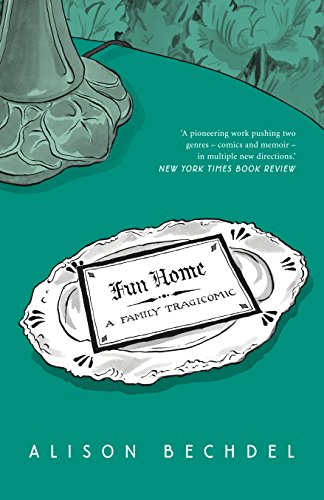

Both of these books were beautiful and devastating. I was very struck by the colour pallete, both are done in black and white with a singular colour wash added to great effect. Fun Home, the first book, is entirely done in a melancholy blue, while Are You My Mother is in red. Both books are autobiographical studies into Bechdel’s childhood and relationships with her parents. Bechdel is a cartoonist, and quite famous for coming up with what is now known as the “Bechdel test”, a depressingly low bar for judging the representation of women in fiction. All it requires to pass the test is for a work of fiction to include:
two women
having a conversation
about something that does not include a man
I don’t think I want to work on quite as memoir heavy a project as these, but I’m glad I’ve read both of them.
Blankets by Craig Thompson
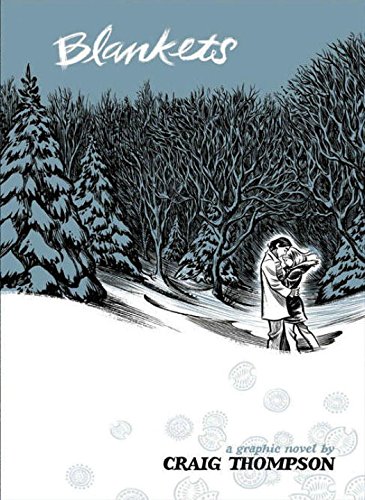
Blankets was probably one of the first autobiographic graphic novels I ever read. The story covers Craig Thompson’s childhood, early adolescence and young adulthood as he navigates his changing relationships to his faith and family and his first romantic relationship. I remember being so impressed with the story when it came out, comics allow for past, present and future all on the same panel, which is something unique to the medium I think. Blankets is thoughtful and beautiful, the artwork is moving and the story touching. This is one I come back to periodically.
Yi-Fu Tuan
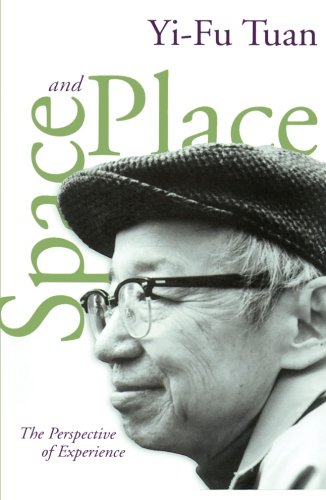
Yi-Fu Tuan was a renowned humanistic geographer responsible for a great deal of thought into place and space. As a fellow immigrant, I was delighted to read several of his books throughout my research, and found them to be interesting, warm and thought provoking. Tuan was an idealist, and a constant optimist and I think I will continue to seek out his books.
I found his thoughts on space vs. place to be very useful in my work. Humans exist in space, but we live in places. According to Tuan, both are necessary to define one another, “Place is security, space is freedom: we are attached to the one and long for the other. There is no place like home.” (Tuan 2001:3). This is not to say that sense of place is only tied to notions of “home”, it is much broader than that. Any space can become place, as long as we have connected meaning or use to it. “When space feels thoroughly familiar to us, it has become place.” (Tuan 2001:73).
Charlotte Linde

Dr. Charlotte Linde is an anthropologist and linguist who specialises in narrative and institutional memory. Notably working for the NASA Ames Intelligent Systems Division and has been described as a “Socio-RocketScientist.” (Linde 2013)
This book was monumentally helpful to me. It is mostly about how people build and develop a “life story” either through the lens of a career, or a more general story. She focuses on the idea of creating coherence, as a social construct that ties into your life story and sense of identity.
“Narrative is among the most important social resources for creating and maintaining personal identity. Narrative is a significant resource for creating our internal, private sense of self and is all the more a major resource for conveying that self to and negotiating that self with others.” (Linde 1993: 98).

Ithel Colquhoun
A chance conversation with an old friend led me to Ithel Calquhoun’s book, The Living Stones. Calquhoun was a surrealist painter, born in India to Scottish parents, she eventually moved to Cornwall. Drawn to the famed light as well as searching for a place of refuge, she bought a small shed in Lamorna where she would retreat from her busier London life. She wrote The Living Stones during this time, covering everything from walking trips to village fairs and feast days, neolithic stones and social gatherings in Penzance. Not quite a travelogue, not quite a research tome, I found myself familiar with every step of her journey. While she was somewhat of an esoteric spiritualist, referring to the spirit of a place quite literally, I too recognise the feelings she described in her rambles through Cornwall. Lamorna is a special place to me, as it is where my wedding reception was held, and as the weather was lovely and we have been researching a story about the sea bucca of Lamorna, we decided to venture out and get some establishing shots. I ended up reading portions of The Living Stones while my husband took shots of the cove, while a solitary seal popped its head out of the water just often enough to keep your attention.
Calquhoun was a fascinating character, and while I had seen her paintings, I was largely unfamiliar with her. The National Trust was home to a large portion of her collection, but the collection was recently purchased by the Tate.
Stewart Lee may seem like an unlikely champion of Colquhoun’s work, but was in fact a key support in getting her books reprinted. He stumbled across an original, signed copy in a bookstore when he was younger and became a staunch fan.
Will Self
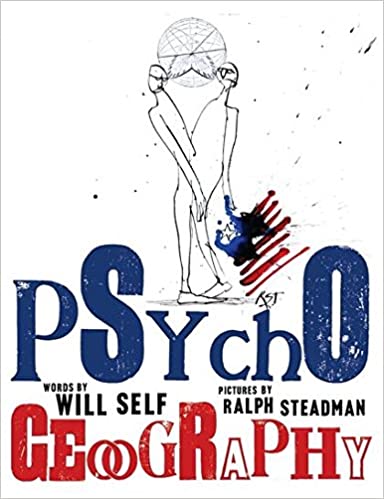
I’m also struggling my way through Will Self’s Psychogeography. I don’t particularly dislike Will Self, I own several of his books and used to enjoy his newspaper columns, but there is something offputting about this collection. I haven’t been able to put my finger on why exactly, but while I connected immediately with Calquhoun’s non-narrative, Self’s book is not as emotionally available. In spite of this, I have found some very resonant experiences, mostly centred around bad experiences with US immigration officials!
He says of his purpose, in walking from London to New York (with the exception of one airline flight to cover the vast ocean issue…)
“I resolved to walk to New York because I had business there, to explore; and, also, because in so doing, I hoped to suture up one of the wounds in my own, divided psyche: to sew together my American and my English flesh, my mother’s and my father’s body bags, sundered by marriage, rived by death.” (Self and Steadman 2007)
I have often wondered if I have left my children with similar issues, but only time will tell.
““Places, I often feel, choose people, not the other way round. Tourism is a search for a place that will embrace you;” (Self 2016:61)”
Philip Marsden
I have also found a book called Rising Ground – A Search for the Spirit of Place by Philip Marsden, which is specifically about Cornwall and seems to tally with my interests very well. I could not find a library copy, so I have ordered a paperback and am looking forward to its arrival. This article written by the author for the Guardian was interesting, even if it inspired a lot of vitriol in the comments section!
https://www.theguardian.com/uk-news/2014/apr/26/survival-of-cornish-identity-cornwall-separate-place

My copy of the Phillip Marsden book I mentioned last week arrived, and it has been a fantastic resources. Marsden covers everything from the concept of topophilia (the love of place) to historical topographers who studied Cornwall, to rambling explorative walks to digging through the archives of the Morrab Library. He covers such a wide range of subjects and history, all linked together by his search for Cornwall’s spirit and mixed with more domestic interludes describing his family’s restoration of a Cornish farmhouse. In addition, the book is quite scholarly, with comprehensive notes and a rich bibliography. Several times Marsden documents visits to libraries, museums, and collections, writing about his sources directly from the originals.
I was struck by his visit to Andrew Lanyon, the son of famous Cornish artist Peter Lanyon, and his evocative descriptions of some of Lanyon’s works.
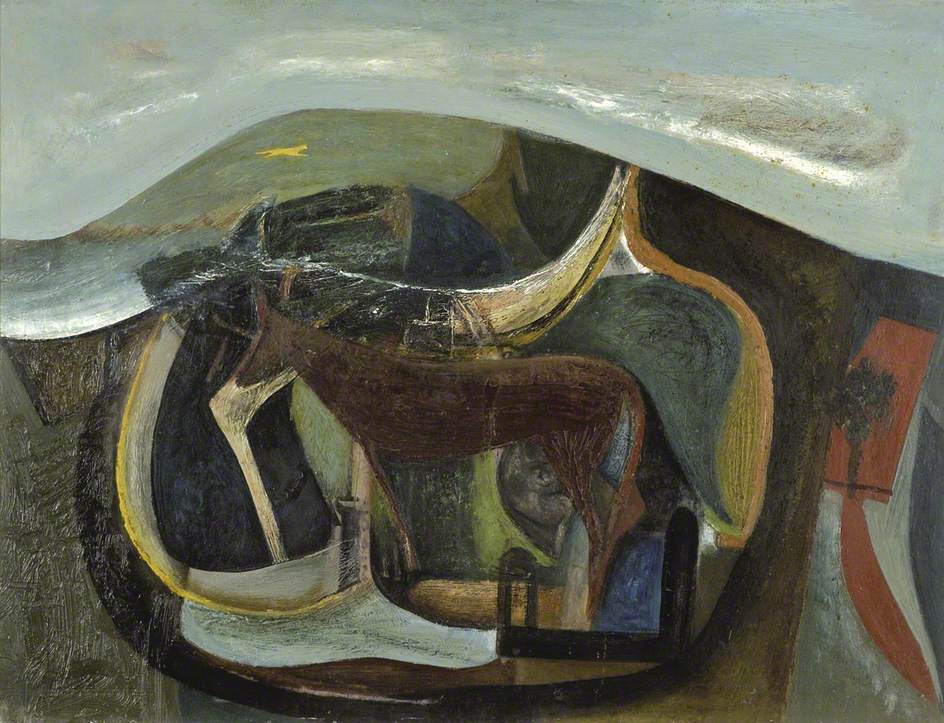
Lanyon, as an artist, was very grounded in a sense of place. Marsden describes Lanyon’s preoccupation with place in Rising Ground, “His paintings were about places, real places. They had names like Bojewyan Arms, Trevelgan, Portreath; they were not just images, but stories.
For him, tackling the big questions meant an understanding of place – not the regional or provincial, but the local, where a single field or a lone cove can conjure up a whole world. In his painting he was trying to recreate a ‘mile of history in a gesture’.” (Marsden 2015 pg. 213) Lanyon was one of the few Cornish artists in the famous St Ives art group, who’s heyday was in the 1950’s and 60’s. Lanyon’s relationship with the rest of the group was volatile, according to Marsden: “His work and his life were a ceaseless struggle between the local and the universal, between the figurative and the abstract, between the place and space. Lanyon describes himself as ‘a place man’: ‘I paint places but always the Placeness of them’.” (Marsden 2015 pg. 210)
I have not finished the entire book yet, but I can already tell it is one I will return to again and again. The sheer breadth of what is covered is staggering, and I enjoy Marsden’s prose and sense of love for place and history that shines through.
The French Dispatch
The French Dispatch is Wes Anderson’s most recent film. Set in the fictional town of Ennui-sur-Blasé, it is an anthology piece centred around a newspaper magazine written in France, but published in Kansas. As a result, many of the writers or people featured in the magazine are travellers of one stripe or another. Four stories and an obituary are featured in the film, and towards the end, there was an interaction that struck me particularly hard. Jeffrey Wright’s character, a journalist covering a private dinner with The Commissaire of the Ennui police force, gets caught up in a mad dash kidnapping plot. He is speaking to Lt. Nescaffier (Steve Park) the police chef who has foiled the plot at great risk to himself.
Lt. Nescaffier: I’m a foreigner, you know.
Roebuck Wright: This city is full of us, isn’t it? I’m one myself.
Lt. Nescaffier: Seeking something missing, missing something left behind.
Roebuck Wright: Maybe with good luck, we’ll find what eluded us in the places we once called home.
References
BBC RADIO 4. 2016. “Stewart Lee on Ithell Colquhoun ~ Books and Authors.” YouTube. Available at: https://www.youtube.com/watch?v=08SLzz_Qpko [accessed 1 Mar 2022].
BECHDEL, Alison. 2006. Fun Home: A Family Tragicomic. Boston: Houghton Mifflin.
BECHDEL, Alison. 2013. Are You My Mother? : A Comic Drama. Boston: Mariner Books.
CONVERY, Ian, Gerard CORSANE and Peter DAVIS. 2012. Making Sense of Place : Multidisciplinary Perspectives. Woodbridge, Suffolk ; Rochester, Ny: Boydell Press.
CRESSWELL, Tim. 2014. Place : An Introduction. Chichester, West Sussex ; Malden, Ma: John Wiley & Sons.
EL REFAIE, Elisabeth. 2016. Autobiographical Comics : Life Writing in Pictures. Jackson: University Press Of Mississippi.
LANYON, Peter. 1946. The Yellow Runner [Oil on board]. Available at: https://artsandculture.google.com/asset/the-yellow-runner-peter-lanyon/mAGmInGhmA2GKQ [accessed 13 Mar 2022].
LINDE, Charlotte. 1993. Life Stories : The Creation of Coherence. New York ; Oxford: Oxford University Press.
LINDE, Charlotte. 2013. ‘Charlotte Linde | Platypus’. Platypus THE CASTAC BLOG [online]. Available at: https://blog.castac.org/author/charlotte-linde/ [accessed 19 Mar 2022].
MARSDEN, Philip. 2014. “Cornish Identity: Why Cornwall Has Always Been a Separate Place.” [online]. Available at: https://www.theguardian.com/uk-news/2014/apr/26/survival-of-cornish-identity-cornwall-separate-place [accessed 1 Mar 2022].
ROTTEN TOMATO TRAILERS. 2015. ‘The Diary of a Teenage Girl Official Trailer #1 (2015) – Alexander Skarsgård, Kristen Wiig Movie HD’. www.youtube.com [online]. Available at: https://www.youtube.com/watch?v=M9LNsSjnqBM [accessed 19 Aug 2022].
SELF, Will and Ralph STEADMAN. 2007. Psychogeography : Disentangling the Modern Conundrum of Psyche and Place. New York: Bloomsbury.
THOMPSON, Craig. 2017. Blankets. London Faber & Faber.
TUAN, Yi-Fu. 1977. Space and Place: The Perspective of Experience. Minneapolis, Mn: University Of Minnesota Press.
